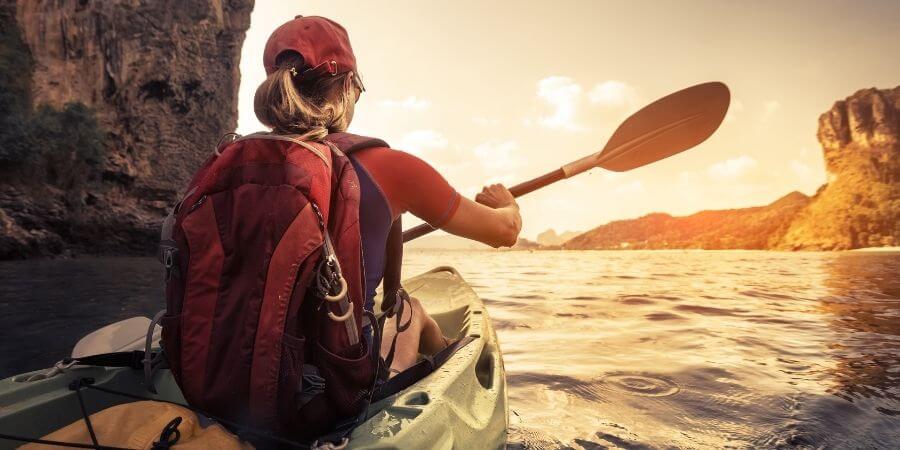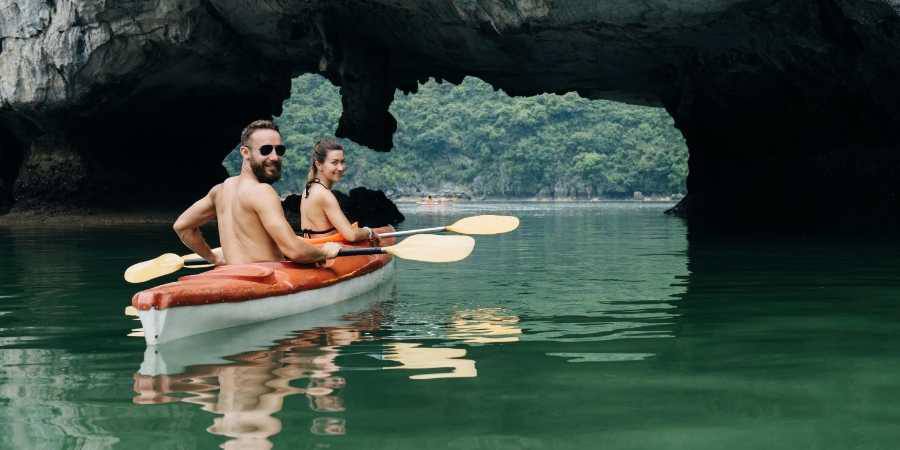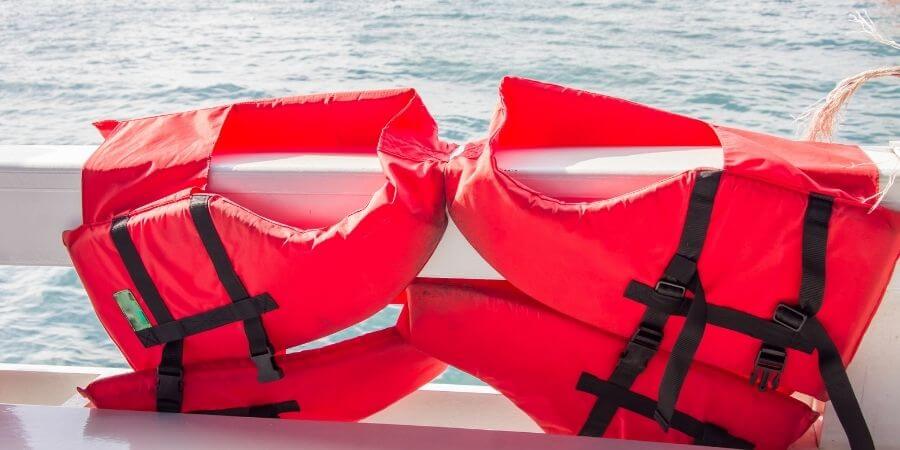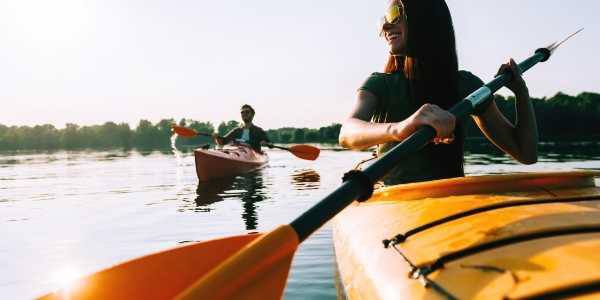Kayaking isn’t that much different than hiking…
…when it comes to the dress code.
As with most outdoor activities, you should wear comfortable, versatile clothing. If your gear is also durable, you’ve hit the jackpot.
What’s even more critical with kayaking than hiking, though, is that you should be prepped for wetness.
Here are some basic rules to keep in mind:
- Use a personal flotation device, such as a buoyancy aid or life jacket. Don’t take these off when you’re on the water ever. It’s best to wait until you’ve reached the shore or until a friend can hold your kayak firmly in place.
- Consider the water temperature, not the air temperature, when choosing your outfit.
- Wear several layers. None of these layers should be cotton, though, because cotton absorbs moisture. Also, focus on comfortable clothes that don’t restrict your range of motion.
- Choose abrasion-resistant and corrosion-proof materials if you want your clothes to pass the test of time. Otherwise, the sand, water, and other things on your kayak will damage your clothes faster. Metal materials won’t last long on the water, so choose equipment that uses rigid plastic parts instead of metal parts (e.g., zippers).
- Wear sun protection, aka UPF-rated clothes and sunscreen for your face.
Table of Contents
What to Wear Kayaking in the Spring
If you’re going kayaking in milder weather, you should wear the following:
- Underwear: Comfortable swimsuit not made from cotton.
- Top: Consider rashguards because they’re made from moisture-wicking materials like nylon, lycra, and polyester. Besides, these materials offer you the flexibility of movement and sun protection. However, you can consider another synthetic or wool top.
- Water shirt: These are looser, so they’re best if you won’t be swimming. However, choose one with sun protection.
- Bottoms: Consider quick-dry pants or board shorts. These bottoms should feel comfortable and non-chafing. Avoid thin materials because they wear quickly.
- Mid-layer: Consider a wetsuit or drysuit if you’re swimming. If not, choose a warm, non-cotton pullover.
- Outer layer: If the weather is rainy or windy, wear a waterproof jacket and pants. You can also consider a paddling coat that doesn’t let water get through the cuffs.
- Footwear: Neoprene boots or other light, waterproof footwear is excellent. You can even wear water sandals but prepare for sand and gravel to get inside. Avoid flip-flops because they can slip off.
- Pro tip: Remember to wear waterproof or, at least, moisture-wicking socks.
- Hat: Wear a wide-brim hat that offers you increased sun protection. Straps would be perfect to keep that hat on your head when it’s windy outside. If it’s colder outside, wear a beanie under the cap for more warmth.
- Paddling gloves: These gloves are waterproof and grippy.
- Personal floating device: Never go on the water without it.
What to Wear Kayaking in the Winter
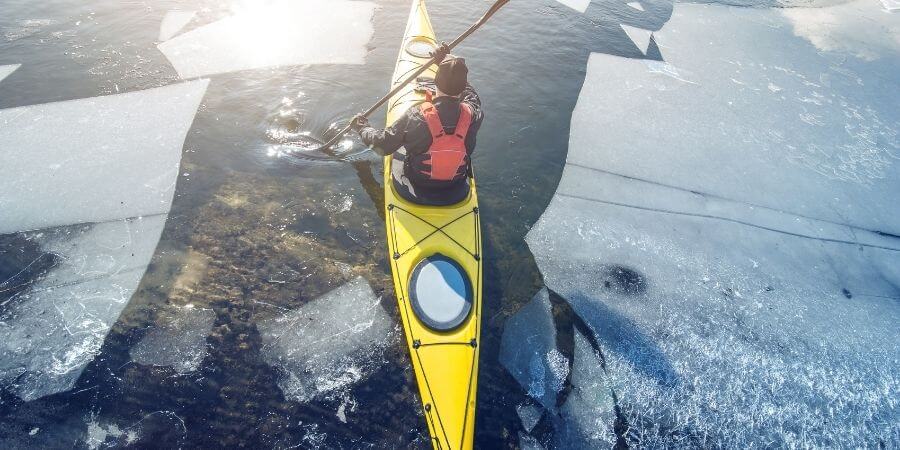
Capsizing isn’t fun. So, if the temperatures are below 70F, you should wear a wetsuit or drysuit. Here’s the difference:
- Wetsuits are usually made from thick neoprene. They keep your body warm because they trap a thin layer of water next to your skin. Your body heats this layer of water, and, as it’s trapped next to your skin, it gives that warmth back.
- Drysuits are more effective in colder conditions. They’re waterproof, so your body will remain completely dry. If the weather you’re kayaking in is freezing, put on some insulating underwear too.
That means:
- Wetsuits are better for warm air and cold water (late spring and early autumn).
- Drysuits are better for cold air and cold water (the rest of the cold season).
What to Wear Kayaking with a Wetsuit
If that wetsuit has long sleeves, wear:
- Base layer: Swimwear or regular underwear. You don’t need moisture-wicking materials because a wet suit traps water underneath your skin.
- Mid-layer: You don’t need any. If the temperatures are low, consider a thicker wetsuit.
- Outer layer: Wetsuits aren’t windproof, so kayaking in windy conditions will make your basal temperature drop. So, consider a windproof jacket and pants.
- Footwear: Neoprene boots are the best.
- Gloves: You need warm, insulating, and waterproof gloves.
- PFD
If that wetsuit has short sleeves, wear:
- Base layer: A quick-dry top that covers your arms or a rashguard for added warmth and protection from UV rays. For cold air, you’ll want a top with heavy wicking potential.
- Mid-layer: Fleece jacket.
- Outer-layer: Wind- and waterproof equipment, such as a rain jacket and pants.
- Footwear: Neoprene boots are the best.
- Gloves: You need warm, insulating, and waterproof gloves
- PFD
What to Wear Kayaking with a Dry Suit
Remember that a dry suit keeps your body warm and dry. Thus, you’ll need:
- Base layer: Long, moisture-wicking underwear.
- Mid-layer: Fleece layer over that base layer in freezing weather.
- Outer layer: None is required.
- Footwear: Neoprene boots are the best.
- Gloves: You need warm, insulating, and waterproof gloves.
- PFD
What to Wear Kayaking in the Summer
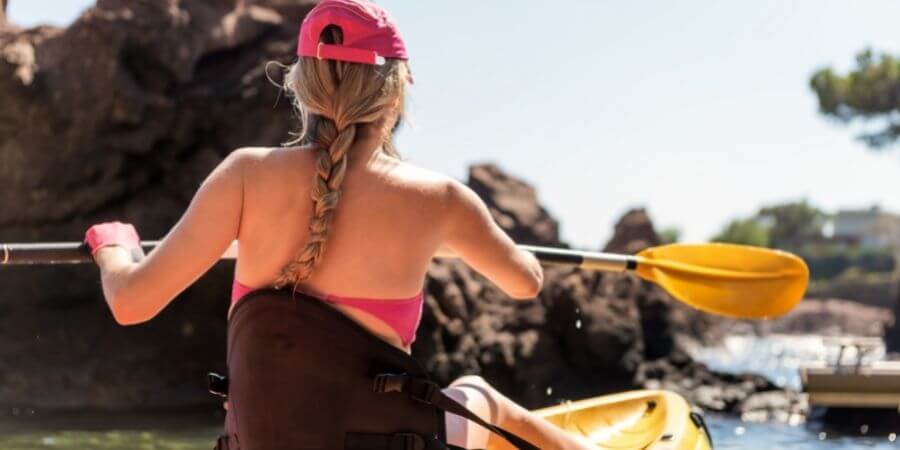
Kayaking in the summer means you’ll be wearing less clothing. Here’s what you should consider:
- Base layer: Swimsuit
- Outer-layer: Quick-dry shirt and pants, preferably with long sleeves and sun protection. Otherwise, wear sunscreen.
- Hat: Wear a large-brimmed hat with high UPF protection.
- Sunscreen: You don’t want to get those sunburns that combine UV rays directly from the sun with UV rays reflected from the water.
- Eyeglasses: The sun rays reflected in the water are straight-up blinding, and you have to protect your eyes.
- Footwear: Wear water sandals if you don’t mind sand and muck getting near your feet. Otherwise, consider waterproof shoes.
- PFD
Also, if you plan to go for a swim, get a waterproof bag for your things.
In Conclusion
Now that you know what to wear kayaking, you’re ready for your first safe adventure. As you can see, you’ll want to wear comfortable, secure, and moisture-wicking clothes that don’t hinder your movements.
You don’t have to spend a king’s ransom for these. Wear anything you have in your closet if it fits this description.
The only things not to compromise on are a water suit in cold weather, sun protection, and a personal flotation device. And if you haven’t bought a kayak yet, read this article about the best inflatable kayaks on the UK market.
